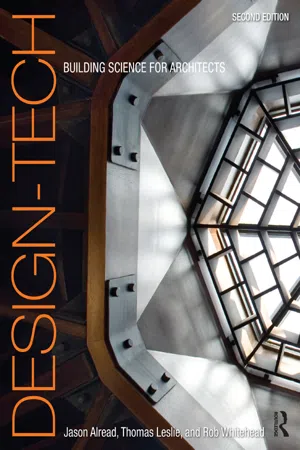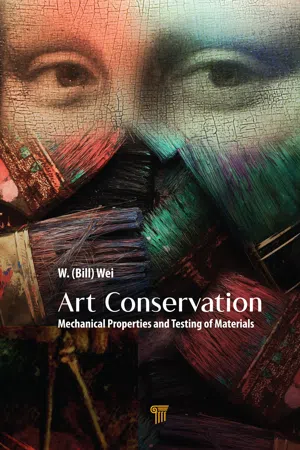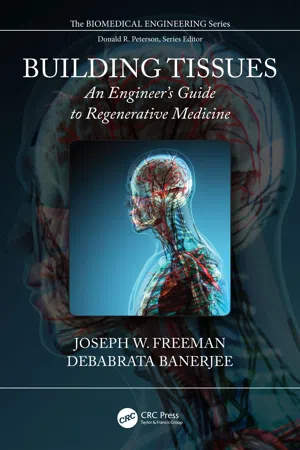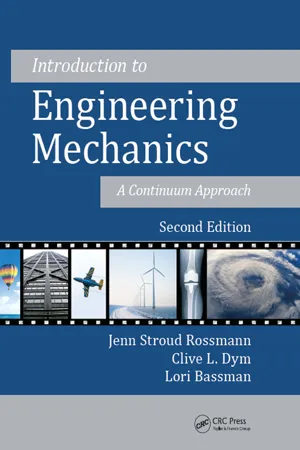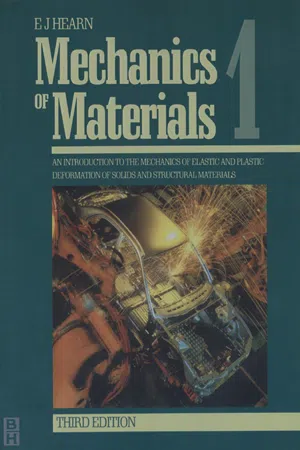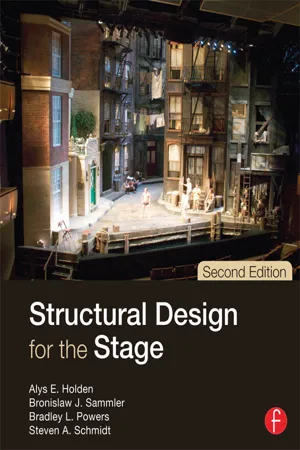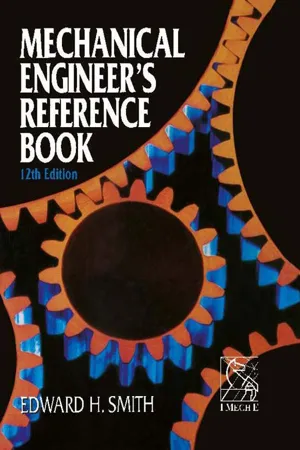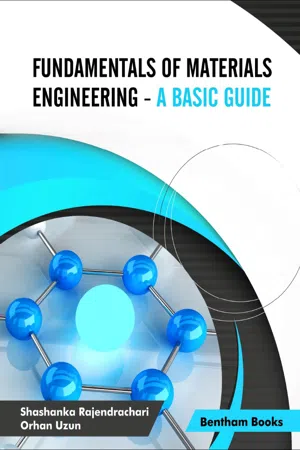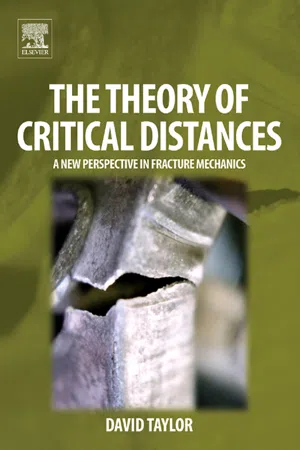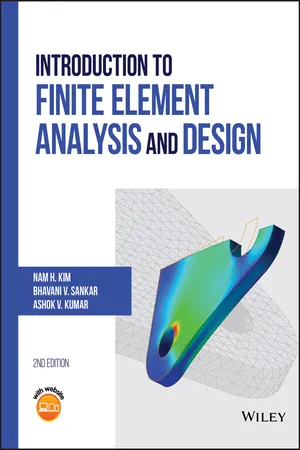Technology & Engineering
Stress and Strain
Stress and strain are fundamental concepts in the field of materials science and engineering. Stress refers to the internal force within a material, while strain is the measure of deformation caused by stress. Understanding the relationship between stress and strain is crucial for designing and analyzing the behavior of materials under different conditions.
Written by Perlego with AI-assistance
Related key terms
Related key terms
1 of 4
Related key terms
1 of 3
12 Key excerpts on "Stress and Strain"
- eBook - ePub
Design-Tech
Building Science for Architects
- Thomas Leslie, Robert Whitehead(Authors)
- 2014(Publication Date)
- Routledge(Publisher)
r = 0.658″ or approx. 5/8″Designers can use this information to evaluate the ramifications on the sizing and spacing of support elements if any of the design factors were to change. For instance, because the load and component size (area) are directly proportional, if the spacing of the cables were to double (thereby doubling the tributary area), the area of the cable would also have to double (although because it is a circle, doubling the area doesn't double the radius).However, in these examples we are only evaluating an element based on its capacity to carry a load, in other words, its strength. Under stress, each element will also deform, and so the relative value of a material's stiffness also needs to be evaluated.Stresses and Strains
Loads cause stress (tension, compression, bending or torsion) and stresses deform or strain supporting members. In the simplest terms, stress is what is felt, strain is what happens as a result. Different types of stress cause different types of deformations to occur. Initially we will focus on the strains caused by the axial stresses of tension and compression. If an object is pulled or pushed under loading it changes from its original shape by becoming shorter or longer—these strains are often too small to see, but the change does occur.Simply put, strain, s, is a measure of an object's change in length (defection), e, compared to its original length, L, as described in the equation.s = e / LIn 1678, Robert Hooke, an associate of London architect Christopher Wren, discovered two key laws of structural behavior related to Stress and Strain.First, he found that the strain of a material is always proportional to the stress it undergoes, or in Hooke's words, “Ut tensio, sic vis” (“As the elongation, so is the force”). This means that doubling the force on a given structural member will double its deformation (Figure 21.4 - eBook - ePub
Art Conservation
Mechanical Properties and Testing of Materials
- W. (Bill) Wei(Author)
- 2021(Publication Date)
- Jenny Stanford Publishing(Publisher)
In conservation, we are generally dealing with stresses and eventually things breaking when the stress reaches the material’s strength. However, in many engineering/industrial applications, and in some exceptional cases in conservation, especially of industrial heritage objects, one failure criterion is that something deforms too much. The next time the reader flies in a passenger airplane, take a look at the front of the jet engine. There, one will see the so-called fan turning. In operation, each fan blade will be loaded by a centrifugal force, which translates into a stress, which further translates into strain of the blade during flight. It is not particularly pleasant if the strain is so great that the fan blade comes in contact with the turbine engine housing. Thus, analogous to the force/stress situation, engineers who design these parts cannot go to suppliers and expect them to tell them how much a material will lengthen under a given force. They must translate that into strain under a given stress. The supplier can then provide information on the strain behavior of materials, information which is useful for every client.2.3 The Relationship between Stress and StrainStress and Strain are related as one might expect. As the force is increased for the tensile test discussed in Fig. 2.1 or 2.6 , a graph will be obtained showing the relationship between the applied force on the specimen and the change in length for a typical metal (see Fig. 2.8a ). These results can be calculated into Stress and Strain based on the original load-carrying area of the specimen, A0 , and the original length of the specimen l0 , as defined in Fig. 2.6 . This results in a so-called engineering stress-strain (σ-ε) diagram as shown schematically in Fig. 2.8b .Figure 2.8 Schematic (a) load elongation and (b) stress-strain diagrams for a typical metal.For most metals, the increase in strain with an increase in stress begins as a straight line. This is called “linear” behavior. This part of the graph also describes something known as elastic behavior. If you stressed the material to, say point 2 in Fig. 2.8b and then unstressed it, the specimen would go back to its original length. A material is thus called elastic in technical terms when it returns back to its original form after being deformed. If the stress-strain curve is a straight line as in the lower part of Fig. 2.8b , we say that the material shows linear-elastic behavior.At a certain point for metals, the stress level, σy , the curve starts to bend and eventually reaches a maximum at the stress level, σUTS in the tensile case, or more generally, σf . The curve then bends down to the X which marks the point at which the specimen breaks or technically, fractures - Josip Brnic(Author)
- 2018(Publication Date)
- Wiley(Publisher)
7 Relationships Between Stress and Strain 7.1 Fundamental Considerations When a solid body is subjected to a load, it experiences changes in its volume and/or shape. The analysis of the stress in solid bodies (deformable bodies) is of interest in the design process. On the basis of previous analyses, it is evident that the state of stress may be defined by the stress tensor and the state of strain may be defined by the strain tensor. In the solving of problems in the field of elastostatics, there are six unknowns in the stress tensor (Equation (2.6)), six unknowns in the strain tensor (Equation (3.19)) and three unknowns in the displacement vector (Equation (3.20)). The above implies that the tensor components are symmetric with respect to the main diagonal of the tensor. There are fifteen unknowns in total. This means that one needs to have fifteen equations if the unknowns need to be derived. However, the theory of stress and the theory of strain are derived “in general”. This means that the theories have been derived independent of the material properties; that is, independent of the material from which the considered body is made. As such, the theory of stress is based on the equilibrium of forces while the theory of deformation is based on the compatibility of geometry. It is to be expected that the stress occurring in a body is associated with the deformation and the material properties. The question that arises is what the relationship between Stress and Strain is. It is very difficult to find universal equations that can be used to summarise the relationship between Stress and Strain for all of types of solid bodies, and especially if all of types of continuum are considered- eBook - ePub
Building Tissues
An Engineer's Guide to Regenerative Medicine
- Joseph W. Freeman, Debabrata Banerjee(Authors)
- 2018(Publication Date)
- CRC Press(Publisher)
CHAPTER 1Stress and Strain Analyses 1.1 INTRODUCTIONYour body is subjected to a multitude of forces with every step, every breath, and every heartbeat. A variety of forces can produce different effects on different tissues. When these forces are applied to tissues, they produce stresses and strains. Tendons and ligaments are stretched, bones are compressed, blood shears the inner surfaces of blood vessels and stretches their walls. To function correctly, specific tissues must be able to withstand certain forces. A tissue engineer must be aware of these forces and produce scaffolds that can withstand them when they are implanted. In this section we will introduce the reader to the concepts of force, stress, and strain. For a more in-depth analysis of these topics the reader may want to read Mechanics of Materials by Ferdinand P. Beer, E. Russell Johnston, Jr., and John T. DeWolf or Engineering Mechanics: Statics by J. L. Meriam and L. G. Kraige.1.2 CALCULATING FORCES1 ,2Both of these texts were used as references for this section.These forces are applied in different directions and in different ways. The most commonly studied are normal forces. These forces act perpendicular to the planes that they are affecting and create normal stresses on the object that they are placed on. In this chapter we will review how to solve for the magnitude of forces and use the forces to calculate normal stresses. We will then review how these stresses affect objects through changes in the objects’ lengths.One way to calculate the magnitude of the force acting on an object is to use statics. We will perform a quick review of statics and use it to solve for the forces acting on the tissues in a basic biomechanics problem. Statics allows us to calculate the magnitude of the forces placed on an object through a series of equilibrium balances. For example, we have the following situation: - eBook - ePub
Introduction to Engineering Mechanics
A Continuum Approach, Second Edition
- Jenn Stroud Rossmann, Clive L. Dym, Lori Bassman(Authors)
- 2015(Publication Date)
- CRC Press(Publisher)
P into its components perpendicular and parallel to the section of interest.Interestingly, it took a long time for engineers and scientists to conceptualize stress as we now understand it. While this was partly due to the susceptibility of scientific progress to fads and biases, and the tyranny of Isaac Newton as a trendsetter (more on this later), it was also a result of researchers focusing on whole structures and not “looking inside” the body as the method of section demands. Instead, as J. E. Gordon notes, “all through the eighteenth century and well into the nineteenth, very clever men, such as Leonhard Euler and Thomas Young, performed what must appear to the modern engineer to be the most incredible intellectual contortions”† in order to characterize material behavior without the modern notion of stress.It was Augustin Cauchy who first conceptualized Stress and Strain as we now understand them, in 1822. J. E. Gordon again: “Cauchy perceived that…the ‘stress’ in a solid is rather like the ‘pressure’ in a liquid or a gas. It is a measure of how hard the atoms and molecules which make up the material are being pushed together or pulled apart as a result of external forces.”2.2.1 Normal Stresses
By using the method of sections in one-dimensional loading cases, we can identify two different types of stresses. Consider a straight bar acted on at its ends by two equal and opposite forces, as in Figure 2.8a . Remember that these external forces are called tensile forces. Similarly, the bar in Figure 2.9a is acted on by two equal and opposite forces, directed toward each other; these forces are compressive forces. If we make an imaginary cut through each bar and consider the left-hand segment as a free body, as in Figure 2.8b and 2.9b , we see that for each bar to be in equilibrium, a force P1 , equal and opposite to external force P, must exist. This force P1 is actually an internal force in the original bar that resists the action of force P. Also, we assume that the internal resisting force is uniformly distributed over the cross section of the bar. This force-per-area (the magnitude of the internal force divided by the cross-sectional area) is what we call normal stress - eBook - ePub
Mechanics of Materials Volume 1
An Introduction to the Mechanics of Elastic and Plastic Deformation of Solids and Structural Materials
- E.J. Hearn(Author)
- 1997(Publication Date)
- Butterworth-Heinemann(Publisher)
CHAPTER 1SIMPLE Stress and Strain
1.1 Load
In any engineering structure or mechanism the individual components will be subjected to external forces arising from the service conditions or environment in which the component works. If the component or member is in equilibrium, the resultant of the external forces will be zero but, nevertheless, they together place a load on the member which tends to deform that member and which must be reacted by internal forces which are set up within the material.If a cylindrical bar is subjected to a direct pull or push along its axis as shown in Fig. 1.1 , then it is said to be subjected to tension or compression. Typical examples of tension are the forces present in towing ropes or lifting hoists, whilst compression occurs in the legs of your chair as you sit on it or in the support pillars of buildings.Fig. 1.1 Types of direct stress.In the SI system of units load is measured in newtons , although a single newton, in engineering terms, is a very small load. In most engineering applications, therefore, loads appear in SI multiples, i.e. kilonewtons (kN) or meganewtons (MN).There are a number of different ways in which load can be applied to a member. Typical loading types are:(a) Static or dead loads, i.e. non-fluctuating loads, generally caused by gravity effects.(b) Live loads, as produced by, for example, lorries crossing a bridge.(c) Impact or shock loads caused by sudden blows.(d) Fatigue, fluctuating or alternating loads, the magnitude and sign of the load changing with time.1.2 Direct or normal stress (σ)
It has been noted above that external force applied to a body in equilibrium is reacted by internal forces set up within the material. If, therefore, a bar is subjected to a uniform tension or compression, i.e. a direct force, which is uniformly or equally applied across the cross-section, then the internal forces set up are also distributed uniformly and the bar is said to be subjected to a uniform direct or normal stress - eBook - ePub
- Alys Holden, Bronislaw Sammler, Bradley Powers, Steven Schmidt(Authors)
- 2015(Publication Date)
- Routledge(Publisher)
Concept Box: Example 7 is intended to provide a common situation in which shear must be considered. Note that the allowable shear strength of the A307 bolt was provided, making the problem relatively simple. In practice, determining the grade, strength, and availability of a bolt can be complex. While this text does not cover the design of connections, it is helpful to understand that the SAE (formerly the Society of Automotive Engineers), the ASTM (American Society for Testing and Materials), and the ISO (International Organization for Standards) provide grade specifications for bolts. When selecting a bolt it is critical to know its exact specification, which will allow you to determine material properties such as minimum tensile strength.Flexural Stress
Thus far, we have discussed the elemental forms of stress – tension, compression, and shear. Flexural stress is the result of a horizontal beam supporting a downward load. When a beam bends downward, the top becomes shorter and the bottom becomes longer. Practically, this means that the top half of the beam is in compression and the bottom half is in tension (see Figure 2.17 ). Thus, flexural stress is actually a combination of compression and tension. Flexural stress is examined at length in Chapters 4 , 5 , 8 , and 12 .Figure 2.17 Flexure in a beamStrain and Elasticity
Strain
External forces acting on a body cause internal stresses to develop which cause deformations called strain. Stress cannot be seen, but strain can be seen and measured. As one would expect, tensile stresses cause lengthening deformations and compressive stresses cause shortening deformations. Strain is defined as the amount of deformation per inch of length of the member:s =e lwhere s is the strain, inches/inche is the total deformation, inl is the original length of the member, inHooke's Law
Robert Hooke, a mathematician and physicist of the seventeenth century, discovered what has become known as Hooke’s Law while experimenting with springs. Hooke’s Law states that stress is directly proportional to strain. If twice the stress is applied to a hanger rod, it will lengthen twice as much. In addition, if the stress is removed, the hanger rod will return to its original length. - eBook - ePub
- Edward H. Smith(Author)
- 2013(Publication Date)
- Butterworth-Heinemann(Publisher)
Parameters favouring high creep and rupture strengths Design in the creep range Creep of ferritic pressure vessel steels Remanent life FatigueIntroduction Fatigue crack initiation Fatigue crack propagation Unstable crack growth Final specimen failure Parameters that influence fatigue performance Fatigue testing Design for fatigue Parameters and symbols employedReferences Further reading8.1 Stress and Strain
8.1.1 Fundamental definitions
8.1.1.1 Direct stress σ
The level of direct stress at a point within a loaded body may be considered analogous to the pressure acting in a fluid. It is the measure of the level to which the bonds that hold a structure are being pushed closer (compression - defined negative) or pulled apart (tension - defined positive) (see Figure 8.1 ). It is defined as the normal force per unit area, acting at a point within a material and not associated with any specific area.Figure 8.1 Direct stress acting on a section in a bar8.1.1.2 Shear stress τ
This is again a point quantity and is measured in units of force per unit area. It measures the level by which the bonds are translated with respect to each other. In reality, there is no sign convention for shear stress since there is no physical difference between shearing from right to left or left to right (see Figure 8.2 ).Figure 8.2 Shearing action at a section8.1.1.3 Strain ∈
Strain is a measure of how far apart the bonds are pulled, pushed or translated with respect to each other. Strains are usually quoted as dimensionless quantities with respect to some length dimension. - Shashanka Rajendrachari, Orhan Uzun(Authors)
- 2021(Publication Date)
- Bentham Science Publishers(Publisher)
Original Gauge Length: Before conducting the tensile tests, two permanent marks are made on the test specimen at an appropriate distance called “Original gauge length”. By subtracting the original gauge length (before the test) with final gauge length (after the test) will give the extent of tensile strength of the tested specimen.3. ENGINEERING STRESS-STRAIN CURVES
The stress-strain curves can be obtained during testing a specimen. As we proceed with the test, the length of the specimen increases and the cross-sectional area decreases; but it is assumed here that dimension remains unchanged. Therefore, engineering stress and engineering strain can be explained by the following equations;The load-bearing capacity of materials is called loadability. This is one of the important mechanical properties which decide the strength of materials. The loadability of materials can be studied by using a tensile testing machine (Universal testing machine) by plotting the engineering stress-strain curve. The engineering stress-strain curve is the same as that of the load-extension diagram. This is because, if the parameters on X-axes and Y-axes are divided by some constants, the original diagram remains unchanged. Therefore, only scales on the X and Y-axes will change, but the original diagram remains unaffected. If we divide the extension (X-axis) by the original gauge length, then the property becomes ‘strain'. Similarly, if we divide the load (Y-axis) by the original area, then the property becomes ‘stress’. Therefore, the load-extension diagram and engineering stress-strain diagrams are the same.4. TRUE STRESS-STRAIN CURVES
During the tensile test, the specimen will be pulled apart slowly under applied load until it breaks. The specimen will behave differently from the start of the test until it breaks. These curves can be plotted by using the values of true stress and true strain generated instant to instant during the tensile test. Therefore, it will undergo different phenomena during the test, and it can be divided into four phases or regions, as illustrated in Fig. () [34- eBook - ePub
The Theory of Critical Distances
A New Perspective in Fracture Mechanics
- David Taylor(Author)
- 2010(Publication Date)
- Elsevier Science(Publisher)
Knott, 1973 ). Nevertheless, in this chapter we will briefly review the background material and introduce symbols and terminology, which will be used in the rest of the book. We will be concerned, in general, with the deformation and failure of materials under stress, but emphasis will be placed on those types of failure which will be the main subjects of the book, especially brittle fracture and fatigue, but also including ductile fracture and certain tribological failure modes such as fretting fatigue. Of special interest from a mechanics point of view will be cracks, notches and other combinations of geometry and loading, which give rise to stress concentrations and stress gradients. In this respect, the use of computer-based methods such as finite element analysis (FEA) will also be discussed. We will finish with critical appraisal of the use of traditional fracture mechanics and solid mechanics in failure prediction, setting the scene for the developments to be described in the rest of this book.1.1 Stress–Strain Curves
A fundamental way to obtain information about the mechanical properties of a material is to record its stress–strain curve, usually by applying a gradually increasing tensile strain to a specimen of constant cross section. Figure 1.2 shows, in schematic form, some typical results; note that here we are plotting the true stress (σ ) and true strain (ε), thus taking account of changes in specimen cross section and length during the test. Most materials display a region of linear, elastic behaviour at low strains, and in some cases (line 1) this continues all the way to failure. This is the behaviour of classic brittle materials such as glass and certain engineering ceramics. More commonly, some deviation from linearity occurs before final failure (line 2). This non-linearity has three different sources: (i) non-linear elasticity, which is common in polymers; (ii) plasticity, that is the creation of permanent deformation, which occurs principally in metals and; (iii) damage, which is important in ceramics and composite materials. We will define the stress at failure in all cases as the maximum point in the curve, and refer to it as σ u or the Ultimate Tensile Strength (UTS). In some cases (line 3) complete separation does not occur at σ u - Nam-Ho Kim, Bhavani V. Sankar, Ashok V. Kumar(Authors)
- 2018(Publication Date)
- Wiley(Publisher)
5 Robert Hooke, Jacob Bernoulli, and Leonard Euler are some of the pioneers who developed various theories to explain the bending of beams and stretching of bars. Forces applied to a solid create stresses within the body in order to satisfy equilibrium. These stresses also cause deformation or strains. Accumulation of strains over the volume of a body manifests as deflections or gross deformation of the body. Hence, it is clear that a fundamental knowledge of the relationship between stresses and strains is necessary in order to understand the global behavior. Navier tried to explain deformations considering the forces between neighboring particles in a body, as they tend to separate and come closer. Later this approach was abandoned in favor of Cauchy’s stresses and strains. Robert Hooke was the first one to propose the linear uniaxial stress–strain relationship, which states that the stress is proportional to strain. Later the general relationship between the six components of strains and stresses called the generalized Hooke’s law was developed. The generalized Hooke’s law states that each component of stress is a linear combination of strains. It should be mentioned that stress–strain relationships are called phenomenological models or theories as they are based on the commonly observed behavior of materials and verified by experiments. Only recently, with the advancement of computers and computational techniques, behavior of materials based on first principles or fundamental atomistic behavior is being developed. This new field of study is called computational materials and involves techniques such as molecular dynamics simulations and multiscale modeling. Stress–strain relationships are also called constitutive relationships as they describe the constitution of the material.A cylindrical test specimen is loaded along its axis as shown figure 5.12 . This type of loading ensures that the specimen is subjected to a uniaxial state of stress. If the stress–strain relation of the uniaxial tension test in figure 5.12 is plotted, then a typical ductile material may show a behavior as in figure 5.13 . The explanation of terms in the figure is summarized in table 5.3- eBook - ePub
- James H. Allen(Author)
- 2011(Publication Date)
- For Dummies(Publisher)
Part IV Applying Stress and Strain In this part . . .This part shows you how to apply the principles of Stress and Strain to different types of problems you encounter in mechanics of materials. I start by showing how you can combine different types of stresses from Part II into one combined net effect. I then show you how you can predict deformation based on loads by utilizing stress-strain relationship. You discover how to use these deformation relationships to analyze statically indeterminate structures, and I explain how compression members can experience failure due to geometric considerations as opposed to material stress failure.You also find out how to use all these basic applications to perform basic designs for different types of members. Finally, the part explores analysis techniques that allow you to handle advanced situations, such as impact, that use physics-based work-energy methods and their relationships to Stress and Strain.Passage contains an image
Chapter 15 Calculating Combined Stresses In This ChapterApplying the principle of superpositionCombing stresses from axial, shear, and moment loadsIncorporating torsion into shear applicationsStresses come in a wide array of sources and directions. You may be analyzing the axial loads in the column of a building due to vertical (or gravity) loads when a wind force suddenly hits your building and causes extra bending moments to appear. If you designed only for the vertical axial stresses, your design may not be sufficient for the added stress effects from the bending moments.For scenarios such as this (and for many more different scenarios in general), you need to be able to compute the combined effects of multiple stresses on an object. In this chapter, I show you the basic methodology for combining stresses through a process known as the principle of superposition. I start by explaining several of the key assumptions of this method, and then I show you how to calculate combined stresses for several different categories of stresses.
Index pages curate the most relevant extracts from our library of academic textbooks. They’ve been created using an in-house natural language model (NLM), each adding context and meaning to key research topics.
Explore more topic indexes
Explore more topic indexes
1 of 6
Explore more topic indexes
1 of 4
